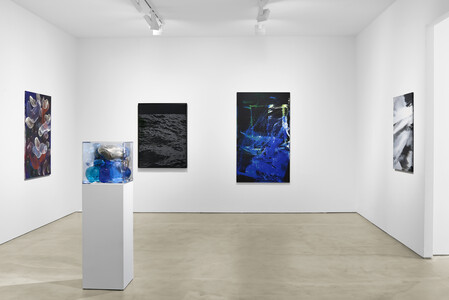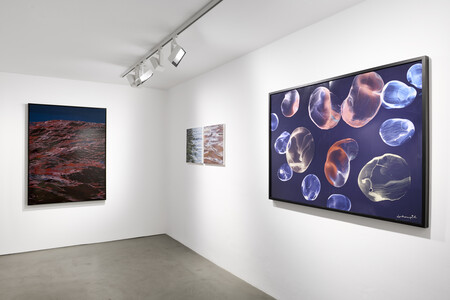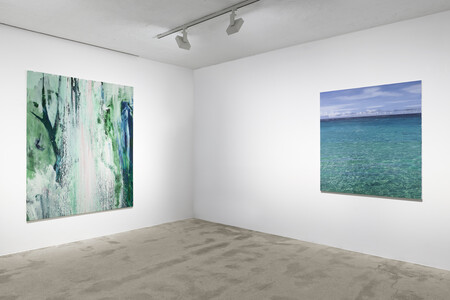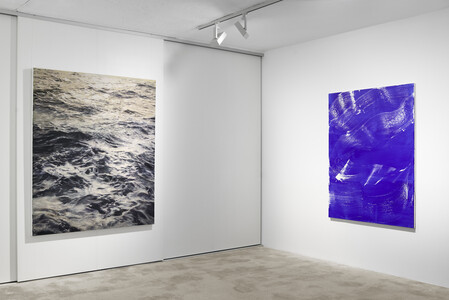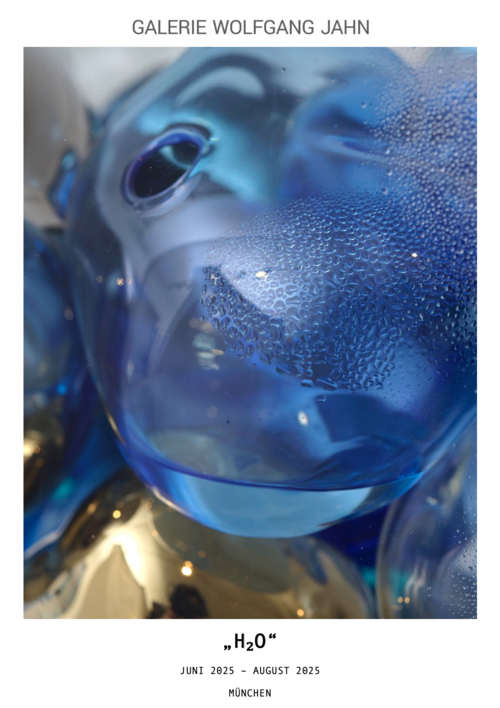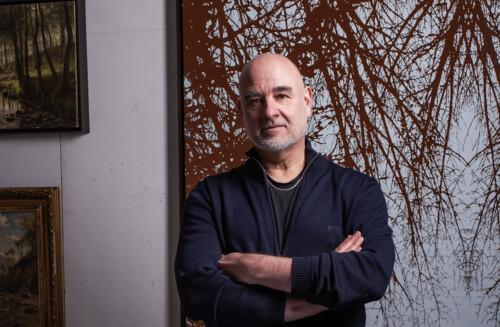H2O
Images of the Exhibition
Description
Under the title “H2O,” the chemical formula for water, the Galerie Wolfgang Jahn in Munich presents selected works by Herbert Brandl, Jiří Georg Dokoupil, Sven Drühl, Stephan Kaluza, Susanne Knaack, Hubert Scheibl, and Bernd Zimmer.
The connecting thread of this group exhibition is the thematic engagement with the element of water — in the form of seascapes, depictions of ocean surf and waves, water surfaces, waterfalls and springs, reflections, rising bubbles, and droplets — extending even to object art that aesthetically illustrates the natural water cycle.
The works differ not only in their individual artistic signatures, techniques, and respective approaches to the theme, but also in their stylistic range. This spectrum spans from breathtaking, photorealistic snapshots (Stephan Kaluza) to graphic minimalism focusing on wave patterns rendered as visual meshworks (Sven Drühl), and expressively charged water landscapes (Susanne Knaack). It continues with the abstracted rendering of nature (Bernd Zimmer) — where deliberate blurring suggests the fleeting dynamism of the moment — and culminates in free, gestural abstractions that only loosely associate with an original visual motif (Herbert Brandl / Hubert Scheibl). Also included are representations of bubble-like forms that are no longer mimetically depicted but instead emerge during the image creation process through the use of delicate soap bubbles (Jiří Georg Dokoupil).
Stephan Kaluza
Stephan Kaluza’s hyperrealistic paintings impress with their meticulous, precise, and richly detailed execution. His images — whether showing coastal views, close-ups of moving waves, shimmering water surfaces, or magnified droplets — are intense snapshots. They depict a hyper-sharpened reality that the human eye, in its constant motion, cannot capture in a single moment.
Kaluza’s works appear like uniformly focused photographs that capture the flowing, smooth, and reflective character of water with striking clarity. The result is a composition with a documentary character, yet aesthetically calibrated. The sea, horizon, and sky, for all their realism, form a banded composition where the foaming wave crests find both formal and chromatic counterparts in the cloud formations above.
Kaluza titles his works “Transit,” referring to the passage from one ephemeral moment to the next. His images reflect a specific momentum — one that the artist seeks to wrest from transience and preserve as a time document of nature. Through an art marked by a lengthy and precise creation process aimed solely at preserving a fleeting instant, Kaluza embodies the ideal of being fully present in the moment.
Nature’s spectacle requires no audience. Yet Kaluza creates a personal projection surface for the viewer, who infuses the scene with their own experiences and emotions. The variety of possible interpretations is underscored by a painting of a Brazilian coastline where Kaluza himself nearly drowned. What for him may evoke trauma, might for another represent a longed-for paradise or holiday memory.
Sven Drühl
Extreme precision — though expressed in a wholly different style — also marks the works of Sven Drühl, a trained mathematician. His nearly monochromatic, surreal images begin as computer-generated designs. He then creates stencils from adhesive film, which he uses in the subsequent painting process.
His conceptual paintings often resemble graphic prints, focusing on the interweaving of linear structures. His lacquer works vividly depict the complex motion of ocean waves — with troughs and crests — without relying on nuanced color variation.
Drühl’s dark, sometimes strikingly bright compositions possess a contemplative calm, paying tribute to the majesty of nature. At the same time, their distorted colors and cropped perspectives, with elevated horizons that place the viewer at water level, introduce a sense of menace and discomfort.
Drühl portrays nature’s power as a sleeping giant, a calm before the storm. His works evoke the isolation only a sailor in the middle of the ocean can feel — knowing that nature has no need of him, and that his presence is a constant flirtation with danger.
Susanne Knaack
Susanne Knaack uses the grisaille technique — working in shades of gray, white, and black — to depict the raw force of foaming, towering waves. Though freely rendered, her paintings remain object-oriented, portraying not specific locations but the elemental forces of nature. These are captured in all their turbulence, often under dramatic skies.
Her seascapes take on a heroic tone, presenting not humans, but nature alone as the conquering protagonist.
At the same time, her works may also be read as soulscapes — using the metaphor of unruly water to reflect existential emotional states. At times, her painting goes beyond mere description, seeking, like water itself, a way out of narrow confines and toward unbounded expression.
Bernd Zimmer
Bernd Zimmer’s works tread a fine line between abstraction and representation. With free, gestural brushwork and expressive color, he paints shimmering movements across water surfaces, where the surrounding nature appears only as distorted reflections in linear and band-like forms.
Elsewhere, it is the explosive power of a foaming mountain stream that captures attention — the environment bursting into a color-storm of suggestion.
A torrent becomes a shower of light and pigment, with rivulets of paint running across the canvas. Here, it is not just the brushstroke that attempts to represent nature — the paint itself, poured and flowing, becomes the medium.
Zimmer’s art remains consciously ambiguous and open. Unlike Kaluza, who captures specific moments with painstaking precision, Zimmer emphasizes blur and uncertainty, suggesting motion and change. Not the single droplet in its falling form, but the composite impression of continual transformation becomes the image.
Herbert Brandl
Herbert Brandl shifts the engagement with the water motif almost entirely into abstraction, where the theme remains only as an association. His use of deep blue symbolizes the fluid element, while winding, transparent traces of white paint suggest wave motion and dynamic energy.
A tumbling swirl of color emerges, with a literally “moving” surface that elevates the act of painting itself to the subject.
In another work, bold strokes in contrasting blues, blacks, and whites evoke a foaming, gushing waterfall. Quick, confident brushwork — sometimes applied with a broad brush — allows the colors to flow into each other, suggesting a rapid, sketch-like execution that mirrors the ever-changing nature of water.
Brandl’s waterfall is not an ode to 19th-century national romanticism, but an effort to approach the essence of surging water masses through open, gestural abstraction — freeing the image from imposed conventions and inviting new perspectives.
Hubert Scheibl
Hubert Scheibl’s composition “Echo Lake” is entirely detached from specific context. A vaguely suggested water structure swells upward, culminating in the upper half of the image — where sky might be expected — in a massive, cresting wave.
This painterly breaker looms like a giant, threatening to crash and collapse at any moment, embodying sheer power and motion.
Scheibl’s upright-floating waves appear surreal and isolated, placed strangely out of place within the image. Detached from any classical seascape motif, they arrive as abrupt incursions — wiping out previous meaning and establishing themselves as abstract pictorial events.
Jiří Georg Dokoupil
Dokoupil’s soap bubble paintings, against blue backgrounds, evoke rising air bubbles in water or jellyfish-like forms drifting in and out of visibility. They hover across the canvas with delicate, almost ghostly elegance.
What fascinates here is the method: these bubbles are not painted in imitation of nature. Instead, they form themselves during the creative act. Dokoupil mixes soap solution with pigments, then drops the bubbles onto the canvas where they burst — leaving behind their own unique traces.
The composition is thus a product of calculated chance, with the artist guiding but not fully controlling the outcome.
In his sculptural work “Open Bubbles Condensation Cube,” Dokoupil presents a Plexiglas container partly filled with water and containing hand-blown glass bubbles. This piece pays homage to his teacher Hans Haacke, who created the “Condensation Cube” in the 1960s — a minimalist artwork illustrating the water cycle. The cube responds to environmental conditions such as light, air movement, and temperature, causing condensation on the walls and forming droplets reminiscent of ephemeral soap bubbles.
Water is the origin and source of life — and has always fascinated humanity with a sense of yearning, reflected in this exhibition from many artistic perspectives. Without water, life would be impossible — or, as the Anglo-American poet W. H. Auden once wrote:
“Thousands have lived without love, not one without water.”
Text: Dr. Veit Ziegelmaier
Photo credit: Produktion Pitz
